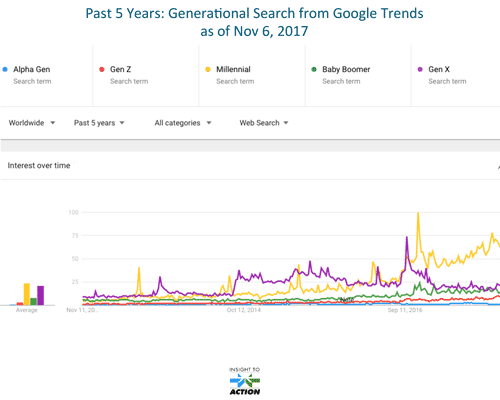Most brands today are focused on Millennials, both as customers and as employees. While the exact cut-off years may vary a bit, this generation was born between 1977-1995 (yellow line in chart). And increasing numbers also see the importance of Gen Z, born between 1996-2010, as evidenced by the increasing red line in the chart.

The newest generation, Alpha Gen, is represented by the blue line at the bottom. They were born since 2011, meaning they are ages seven and younger. Although they are currently the smallest group (both in height and number!), their numbers will grow over time. There were around twenty million children under age five in 2016 according to Census Bureau estimates. To date, interest in this group as measured by Google searches remains modest.
But for K-6 schools, these children are in their kindergarten and first-grade classrooms right now. And for brands who offer entertainment and products for pre-school age users, this group is already the end consumer (even if their Millennial parent or Boomer grandparent is the purchasing decision-maker). This means that for brands where pre-school and elementary school students are part of the picture, it’s time to consider Alpha Gen.
Early Findings about Alpha Gen
I first heard about Alpha Gen from Dawn Aubrey, Associate Director of Housing and Dining Services, University of Illinois, who has been following them closely. Aubrey says,
“While it’s early to tell with Alpha Gen, one of the descriptions is that they are an even faster version of Gen Z. Research shows that they already have a very well-developed visual cortex, and they do multi-tasking and switch off even faster than Gen Z. When it comes to person-to-person connection, they are clustering and becoming inseparable. It’s as if they have their own language and method of communicating, along with their own terms. They see communication devices as the tablet rather than the smartphone.”
Unless long term trends reverse, 20% of these Alpha Gens will be “only” children, born to mothers who have only one child, a trend that has been steadily rising, according to the Pew Center.
The Impact of Mobile Touch Screens
Alpha Gen’s quick ability to process information on a screen and skill with multi-tasking make sense, since they were born after the iPad was introduced in 2010. Some sources find that children who are used to interacting with touch screens, that provide immediate stimuli response, may even learn to prefer this type of interaction to “real-world connection.” Other sources report that Alpha Gen may be more socially isolated. A UCLA 2014 study of Gen Z 6th graders found that diminished tablet use led to improved skills in recognizing human emotions on a face-to-face basis.
As with previous generations, Alpha Gen are typically exposed to hours a day of screen time or media time. But this screen time may be more available to a younger child’s less dexterous fingers at a younger age, given the touch screen technology. They like their touch screens so much in fact that one humorous take referred to them as tastescreens (based on wanting to put everything, including the screen, in their mouth).
Of course, Alpha Gen is still emerging and more will be understood over time. They have yet to live through the most formative years of their lives or share the experiences that will define their generation. In the meantime, parents and grandparents of pre-schoolers and younger elementary-schoolers, their caregivers and early childhood teachers are at the front lines of this generation’s development.
Filed under: Consumer Insights, Market Segmentation, Marketing to Alpha Gen, Marketing to Gen Z, Marketing to Generation X, Marketing to Millennials
Tags: Alpha Gen, Consumer Understanding, Education, Gen Z, Generation X, Millennials, Technology, University of Illinois
Source
http://www.chicagonow.com/marketing-strategist/2018/01/alpha-gen-entering-a-classroom-near-you/


